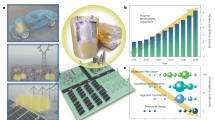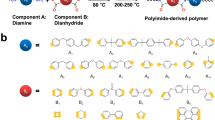Abstract
Dielectric materials, which store energy electrostatically, are ubiquitous in advanced electronics and electric power systems1,2,3,4,5,6,7,8. Compared to their ceramic counterparts, polymer dielectrics have higher breakdown strengths and greater reliability1,2,3,9, are scalable, lightweight and can be shaped into intricate configurations, and are therefore an ideal choice for many power electronics, power conditioning, and pulsed power applications1,9,10. However, polymer dielectrics are limited to relatively low working temperatures, and thus fail to meet the rising demand for electricity under the extreme conditions present in applications such as hybrid and electric vehicles, aerospace power electronics, and underground oil and gas exploration11,12,13. Here we describe crosslinked polymer nanocomposites that contain boron nitride nanosheets, the dielectric properties of which are stable over a broad temperature and frequency range. The nanocomposites have outstanding high-voltage capacitive energy storage capabilities at record temperatures (a Weibull breakdown strength of 403 megavolts per metre and a discharged energy density of 1.8 joules per cubic centimetre at 250 degrees Celsius). Their electrical conduction is several orders of magnitude lower than that of existing polymers and their high operating temperatures are attributed to greatly improved thermal conductivity, owing to the presence of the boron nitride nanosheets, which improve heat dissipation compared to pristine polymers (which are inherently susceptible to thermal runaway). Moreover, the polymer nanocomposites are lightweight, photopatternable and mechanically flexible, and have been demonstrated to preserve excellent dielectric and capacitive performance after intensive bending cycles. These findings enable broader applications of organic materials in high-temperature electronics and energy storage devices.
This is a preview of subscription content, access via your institution
Access options
Subscribe to this journal
Receive 51 print issues and online access
$199.00 per year
only $3.90 per issue
Buy this article
- Purchase on Springer Link
- Instant access to full article PDF
Prices may be subject to local taxes which are calculated during checkout




Similar content being viewed by others
Change history
13 April 2016
A Correction to this paper has been published: https://doi.org/10.1038/nature17673
References
Sarjeant, W. J., Zirnheld, J. & MacDougall, F. W. Capacitors. IEEE Trans. Plasma Sci. 26, 1368–1392 (1998)
Sarjeant, W. J., Clelland, I. W. & Price, R. A. Capacitive components for power electronics. Proc. IEEE 89, 846–855 (2001)
Tan, Q., Irwin, P. & Cao, Y. Advanced dielectrics for capacitors. IEEJ Trans. Fund. Mater. 126, 1152–1159 (2006)
Irvine, J. T. S., Sinclair, D. C. & West, A. R. Electroceramics: characterization by impedance spectroscopy. Adv. Mater. 2, 132–138 (1990)
Reaney, I. M. & Iddles, D. Microwave dielectric ceramics for resonators and filters in mobile phone networks. J. Am. Ceram. Soc. 89, 2063–2072 (2006)
Bell, A. J. Ferroelectrics: the role of ceramic science and engineering. J. Eur. Ceram. Soc. 28, 1307–1317 (2008)
Ogihara, H., Randall, C. A. & Trolier-McKinstry, S. High-energy density capacitors utilizing 0.7 BaTiO3–0.3 BiScO3 ceramics. J. Am. Ceram. Soc. 92, 1719–1724 (2009)
Xiong, B., Hao, H., Zhang, S. J., Liu, H. X. & Cao, M. H. Structure, dielectric properties and temperature stability of BaTiO3–Bi(Mg1/2Ti1/2)O3 perovskite solid solutions. J. Am. Ceram. Soc. 94, 3412–3417 (2011)
Chu, B. J. et al. A dielectric polymer with high electric energy density and fast discharge speed. Science 313, 334–336 (2006)
Ho, J., Jow, T. R. & Boggs, S. Historical introduction to capacitor technology. IEEE Electr. Insul. Mag. 26, 20–25 (2010)
Johnson, R. W., Evans, J. L., Jacobsen, P., Thompson, J. R. & Christopher, M. The changing automotive environment: high-temperature electronics. IEEE Trans. Electron. Packag. Manuf. 27, 164–176 (2004)
Watson, J. & Castro, G. High-temperature electronics pose design and reliability challenges. Analog. Dialog 46, 1–7 (2012)
Weimer, J. A. Electrical power technology for the more electric aircraft. In Proc. AIAA/IEEE Digital Avionics Systems Conf. http://dx.doi.org/10.1109/DASC.1993.283509 (IEEE, 1993)
Rabuffi, M. & Picci, G. Status quo and future prospects for metallized polypropylene energy storage capacitors. IEEE Trans. Plasma Sci. 30, 1939–1942 (2002)
Wang, D. H., Kurish, B. A., Treufeld, I., Zhu, L. & Tan, L. S. Synthesis and characterization of high nitrile content polyimides as dielectric films for electrical energy storage. J. Polym. Sci. A 53, 422–436 (2015)
Ho, J. & Jow, T. R. High field conduction in heat resistant polymers at elevated temperature for metallized film capacitors. In Power Modulator and High Voltage Conf. http://dx.doi.org/10.1109/IPMHVC.2012.6518764 (IEEE, 2012)
Venkat, N. et al. High temperature polymer film dielectrics for aerospace power conditioning capacitor applications. Mater. Sci. Eng. B 168, 16–21 (2010)
Tan, D., Zhang, L. L., Chen, Q. & Irwin, P. High-temperature capacitor polymer films. J. Electron. Mater. 43, 4569–4575 (2014)
Pan, J. L., Li, K., Chuayprakong, S., Hsu, T. & Wang, Q. High-temperature poly(phthalazinone ether ketone) thin films for dielectric energy storage. ACS Appl. Mater. Interf. 2, 1286–1289 (2010)
Dean, C. R. et al. Boron nitride substrates for high-quality graphene electronics. Nature Nanotechnol. 5, 722–726 (2010)
Sevik, C., Kinaci, A., Haskins, J. B. & Çağın, T. Characterization of thermal transport in low-dimensional boron nitride nanostructures. Phys. Rev. B 84, 085409 (2011)
Coleman, J. N. et al. Two-dimensional nanosheets produced by liquid exfoliation of layered materials. Science 331, 568–571 (2011)
Ieda, M. Dielectric breakdown process of polymers. IEEE Trans. Electr. Insul. 15, 206–224 (1980)
Li, Q. et al. Solution-processed ferroelectric terpolymer nanocomposites with high breakdown strength and energy density utilizing boron nitride nanosheets. Energy Environ. Sci. 8, 922–931 (2015)
Dang, Z. M., Yuan, J., Yao, S. H. & Liao, R. J. Flexible nanodielectric materials with high permittivity for power energy storage. Adv. Mater. 25, 6334–6365 (2013)
Montanari, D. et al. Film capacitors for automotive and industrial applications. In Proc. CARTS USA 23–38 (Electronic Components Industry Association, 2009)
O'Dwyer, J. J. The Theory of Electrical Conduction and Breakdown in Solid Dielectrics Ch. 1 (Clarendon, 1973)
Qin, S., Ho, J., Rabuffi, M., Borelli, G. & Jow, T. R. Implications of the anisotropic thermal conductivity of capacitor windings. IEEE Electr. Insul. Mag. 27, 7–13 (2011)
Zebouchi, N. et al. Electrical breakdown theories applied to polyethylene terephthalate films under the combined effects of pressure and temperature. J. Appl. Phys. 79, 2497–2501 (1996)
Mark, J. E. Physical Properties of Polymers Handbook Ch.10 (AIP Press, 1996)
Acknowledgements
Q.W. acknowledges financial support from the US Office of Naval Research under grant number N00014-11-1-0342. L.-Q.C. is supported by the Air Force Office of Scientific Research under grant number FA9550-14-1-0264. H.U.L. and T.N.J. acknowledge support from the Dow Chemical Corporation.
Author information
Authors and Affiliations
Contributions
Q.W. and Q.L. devised the original concept. Q.L. and M.R.G. were responsible for materials synthesis and characterization. Q.L., M.R.G. and G.Z performed dielectric and polarization-loop measurements. L.C. and L.-Q.C. carried out simulation studies. S.Z. and Q.L. performed the studies of high-Tg dielectric polymers. H.U.L. and T.N.J. designed the bending tests. E.I. provided research-grade BCB used in the preparation of the samples reported, and also participated in helpful discussions. A.H. measured thermal conductivities. Q.W. and Q.L. wrote the first draft of the manuscript, and all authors participated in manuscript revision.
Corresponding author
Ethics declarations
Competing interests
The authors declare no competing financial interests.
Supplementary information
Supplementary Information
This file contains Supplementary Text, Supplementary Figures 1-36, Supplementary Tables 1-6 and additional references. (PDF 6640 kb)
Bending test of c-BCB/BNNS films
A c-BCB/BNNS film is bended repeatedly to a bending radius of 4 mm with a homemade setup. (MP4 24791 kb)
Rights and permissions
About this article
Cite this article
Li, Q., Chen, L., Gadinski, M. et al. Flexible high-temperature dielectric materials from polymer nanocomposites. Nature 523, 576–579 (2015). https://doi.org/10.1038/nature14647
Received:
Accepted:
Published:
Issue Date:
DOI: https://doi.org/10.1038/nature14647
This article is cited by
-
Polymer nanocomposite dielectrics for capacitive energy storage
Nature Nanotechnology (2024)
-
Roll-to-roll fabricated polymer composites filled with subnanosheets exhibiting high energy density and cyclic stability at 200 °C
Nature Energy (2024)
-
Ultraviolet-Irradiated All-Organic Nanocomposites with Polymer Dots for High-Temperature Capacitive Energy Storage
Nano-Micro Letters (2024)
-
Design strategies of high-performance lead-free electroceramics for energy storage applications
Rare Metals (2024)
-
Significantly Enhanced Energy Storage Performances of PEI-based Composites Utilizing Surface Functionalized ZrO2 Nanoparticles for High-Temperature Application
Chinese Journal of Polymer Science (2024)
Comments
By submitting a comment you agree to abide by our Terms and Community Guidelines. If you find something abusive or that does not comply with our terms or guidelines please flag it as inappropriate.



